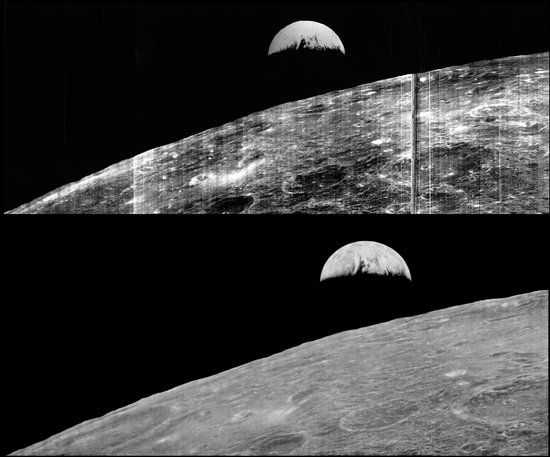

What is the Lunar Orbiter Image Recovery Project you ask?
LOIRP, as it’s abbreviated, is a project, funded by NASA and SkyCorp, dedicated to refurbishing and reprocessing images taken between 1966 and 1967 by the five Lunar Orbiters NASA sent to the moon in an attempt to study the moon, but primarily to find suitable landing surfaces for the Apollo missions. These images were taken on analog data tape (you know, ‘real’ film – not this fancy modern digital magic). In addition, this project will scan and digitize the data for preservation in cyberspace.
These orbiters did more than pave the way for the Apollo missions, they were also responsible for showing us some of the most detailed images of the moon yet – not to mention allowing humanity to see the Earth as seen from space (at any reasonable distance) for the very first time in human history. To understand the sheer difference in quality of the originally released image and the reprocessed version, you need only to look at the picture posted above.

In order to reprocess these images, the LOIRP engineering team needs to use some seriously outdated equipment. Generally, I’ve seen this process referred to as “technoarchaeology,” that is, finding and using antiquated technologies to preserve scientific knowledge for the future. After all, you can have all of the vinyl records ever produced and, without a record player, they are worthless. Currently, the LOIRP project is running a donation drive to help fund its efforts.
In this case, the team is in desperate need of refurbishing the five tape drive heads. If you recall from the age before DVDs, these heads are responsible for reading the actual film. The process of running the tape grinds the tape drive heads just like sandpaper. As you can imagine, this isn’t a good thing.
There are over 700 tapes left to be reprocessed, containing about 20 terabytes of data in total. At this point, I’d like to direct you to LOIRP’s project page where you can offer a donation to help fund the project. At the moment, the drive has 7 days left and the project has nearly broken the $12,000 mark of their $75,000 goal.
As you know, on FQTQ we don’t usually ask you to donate, but we think this drive is worth an exception. It would be a tragedy to lose 20,480 gigabytes worth of scientific data and human history.